Sihyun Yu
ContextVLA: Vision-Language-Action Model with Amortized Multi-Frame Context
Oct 05, 2025Abstract:Leveraging temporal context is crucial for success in partially observable robotic tasks. However, prior work in behavior cloning has demonstrated inconsistent performance gains when using multi-frame observations. In this paper, we introduce ContextVLA, a policy model that robustly improves robotic task performance by effectively leveraging multi-frame observations. Our approach is motivated by the key observation that Vision-Language-Action models (VLA), i.e., policy models built upon a Vision-Language Model (VLM), more effectively utilize multi-frame observations for action generation. This suggests that VLMs' inherent temporal understanding capability enables them to extract more meaningful context from multi-frame observations. However, the high dimensionality of video inputs introduces significant computational overhead, making VLA training and inference inefficient. To address this, ContextVLA compresses past observations into a single context token, allowing the policy to efficiently leverage temporal context for action generation. Our experiments show that ContextVLA consistently improves over single-frame VLAs and achieves the benefits of full multi-frame training but with reduced training and inference times.
Enhancing Motion Dynamics of Image-to-Video Models via Adaptive Low-Pass Guidance
Jun 10, 2025Abstract:Recent text-to-video (T2V) models have demonstrated strong capabilities in producing high-quality, dynamic videos. To improve the visual controllability, recent works have considered fine-tuning pre-trained T2V models to support image-to-video (I2V) generation. However, such adaptation frequently suppresses motion dynamics of generated outputs, resulting in more static videos compared to their T2V counterparts. In this work, we analyze this phenomenon and identify that it stems from the premature exposure to high-frequency details in the input image, which biases the sampling process toward a shortcut trajectory that overfits to the static appearance of the reference image. To address this, we propose adaptive low-pass guidance (ALG), a simple fix to the I2V model sampling procedure to generate more dynamic videos without compromising per-frame image quality. Specifically, ALG adaptively modulates the frequency content of the conditioning image by applying low-pass filtering at the early stage of denoising. Extensive experiments demonstrate that ALG significantly improves the temporal dynamics of generated videos, while preserving image fidelity and text alignment. Especially, under VBench-I2V test suite, ALG achieves an average improvement of 36% in dynamic degree without a significant drop in video quality or image fidelity.
Learning Flexible Forward Trajectories for Masked Molecular Diffusion
May 22, 2025Abstract:Masked diffusion models (MDMs) have achieved notable progress in modeling discrete data, while their potential in molecular generation remains underexplored. In this work, we explore their potential and introduce the surprising result that naively applying standards MDMs severely degrades the performance. We identify the critical cause of this issue as a state-clashing problem-where the forward diffusion of distinct molecules collapse into a common state, resulting in a mixture of reconstruction targets that cannot be learned using typical reverse diffusion process with unimodal predictions. To mitigate this, we propose Masked Element-wise Learnable Diffusion (MELD) that orchestrates per-element corruption trajectories to avoid collision between distinct molecular graphs. This is achieved through a parameterized noise scheduling network that assigns distinct corruption rates to individual graph elements, i.e., atoms and bonds. Extensive experiments on diverse molecular benchmarks reveal that MELD markedly enhances overall generation quality compared to element-agnostic noise scheduling, increasing the chemical validity of vanilla MDMs on ZINC250K from 15% to 93%, Furthermore, it achieves state-of-the-art property alignment in conditional generation tasks.
MALT Diffusion: Memory-Augmented Latent Transformers for Any-Length Video Generation
Feb 18, 2025Abstract:Diffusion models are successful for synthesizing high-quality videos but are limited to generating short clips (e.g., 2-10 seconds). Synthesizing sustained footage (e.g. over minutes) still remains an open research question. In this paper, we propose MALT Diffusion (using Memory-Augmented Latent Transformers), a new diffusion model specialized for long video generation. MALT Diffusion (or just MALT) handles long videos by subdividing them into short segments and doing segment-level autoregressive generation. To achieve this, we first propose recurrent attention layers that encode multiple segments into a compact memory latent vector; by maintaining this memory vector over time, MALT is able to condition on it and continuously generate new footage based on a long temporal context. We also present several training techniques that enable the model to generate frames over a long horizon with consistent quality and minimal degradation. We validate the effectiveness of MALT through experiments on long video benchmarks. We first perform extensive analysis of MALT in long-contextual understanding capability and stability using popular long video benchmarks. For example, MALT achieves an FVD score of 220.4 on 128-frame video generation on UCF-101, outperforming the previous state-of-the-art of 648.4. Finally, we explore MALT's capabilities in a text-to-video generation setting and show that it can produce long videos compared with recent techniques for long text-to-video generation.
Efficient Long Video Tokenization via Coordinate-based Patch Reconstruction
Nov 26, 2024



Abstract:Efficient tokenization of videos remains a challenge in training vision models that can process long videos. One promising direction is to develop a tokenizer that can encode long video clips, as it would enable the tokenizer to leverage the temporal coherence of videos better for tokenization. However, training existing tokenizers on long videos often incurs a huge training cost as they are trained to reconstruct all the frames at once. In this paper, we introduce CoordTok, a video tokenizer that learns a mapping from coordinate-based representations to the corresponding patches of input videos, inspired by recent advances in 3D generative models. In particular, CoordTok encodes a video into factorized triplane representations and reconstructs patches that correspond to randomly sampled $(x,y,t)$ coordinates. This allows for training large tokenizer models directly on long videos without requiring excessive training resources. Our experiments show that CoordTok can drastically reduce the number of tokens for encoding long video clips. For instance, CoordTok can encode a 128-frame video with 128$\times$128 resolution into 1280 tokens, while baselines need 6144 or 8192 tokens to achieve similar reconstruction quality. We further show that this efficient video tokenization enables memory-efficient training of a diffusion transformer that can generate 128 frames at once.
Controllable Human Image Generation with Personalized Multi-Garments
Nov 25, 2024


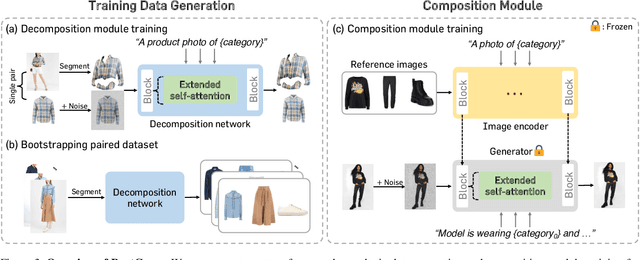
Abstract:We present BootComp, a novel framework based on text-to-image diffusion models for controllable human image generation with multiple reference garments. Here, the main bottleneck is data acquisition for training: collecting a large-scale dataset of high-quality reference garment images per human subject is quite challenging, i.e., ideally, one needs to manually gather every single garment photograph worn by each human. To address this, we propose a data generation pipeline to construct a large synthetic dataset, consisting of human and multiple-garment pairs, by introducing a model to extract any reference garment images from each human image. To ensure data quality, we also propose a filtering strategy to remove undesirable generated data based on measuring perceptual similarities between the garment presented in human image and extracted garment. Finally, by utilizing the constructed synthetic dataset, we train a diffusion model having two parallel denoising paths that use multiple garment images as conditions to generate human images while preserving their fine-grained details. We further show the wide-applicability of our framework by adapting it to different types of reference-based generation in the fashion domain, including virtual try-on, and controllable human image generation with other conditions, e.g., pose, face, etc.
Representation Alignment for Generation: Training Diffusion Transformers Is Easier Than You Think
Oct 09, 2024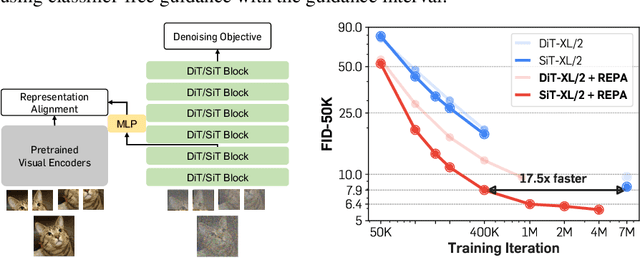


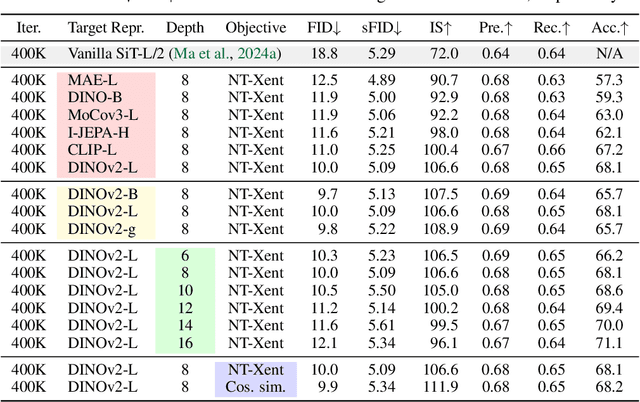
Abstract:Recent studies have shown that the denoising process in (generative) diffusion models can induce meaningful (discriminative) representations inside the model, though the quality of these representations still lags behind those learned through recent self-supervised learning methods. We argue that one main bottleneck in training large-scale diffusion models for generation lies in effectively learning these representations. Moreover, training can be made easier by incorporating high-quality external visual representations, rather than relying solely on the diffusion models to learn them independently. We study this by introducing a straightforward regularization called REPresentation Alignment (REPA), which aligns the projections of noisy input hidden states in denoising networks with clean image representations obtained from external, pretrained visual encoders. The results are striking: our simple strategy yields significant improvements in both training efficiency and generation quality when applied to popular diffusion and flow-based transformers, such as DiTs and SiTs. For instance, our method can speed up SiT training by over 17.5$\times$, matching the performance (without classifier-free guidance) of a SiT-XL model trained for 7M steps in less than 400K steps. In terms of final generation quality, our approach achieves state-of-the-art results of FID=1.42 using classifier-free guidance with the guidance interval.
Data-Efficient Molecular Generation with Hierarchical Textual Inversion
May 05, 2024Abstract:Developing an effective molecular generation framework even with a limited number of molecules is often important for its practical deployment, e.g., drug discovery, since acquiring task-related molecular data requires expensive and time-consuming experimental costs. To tackle this issue, we introduce Hierarchical textual Inversion for Molecular generation (HI-Mol), a novel data-efficient molecular generation method. HI-Mol is inspired by the importance of hierarchical information, e.g., both coarse- and fine-grained features, in understanding the molecule distribution. We propose to use multi-level embeddings to reflect such hierarchical features based on the adoption of the recent textual inversion technique in the visual domain, which achieves data-efficient image generation. Compared to the conventional textual inversion method in the image domain using a single-level token embedding, our multi-level token embeddings allow the model to effectively learn the underlying low-shot molecule distribution. We then generate molecules based on the interpolation of the multi-level token embeddings. Extensive experiments demonstrate the superiority of HI-Mol with notable data-efficiency. For instance, on QM9, HI-Mol outperforms the prior state-of-the-art method with 50x less training data. We also show the effectiveness of molecules generated by HI-Mol in low-shot molecular property prediction.
Efficient Video Diffusion Models via Content-Frame Motion-Latent Decomposition
Mar 21, 2024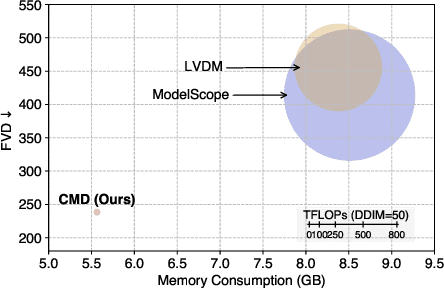
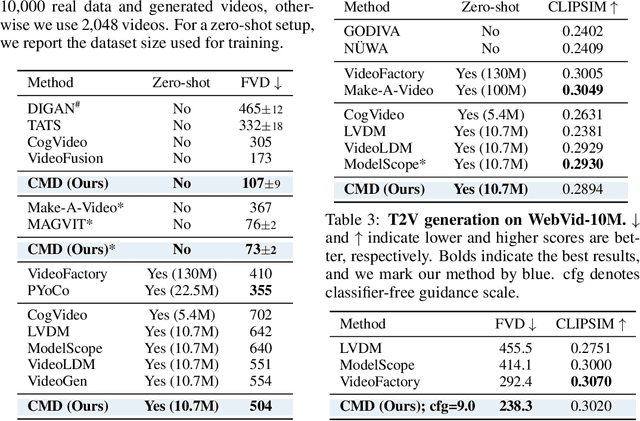


Abstract:Video diffusion models have recently made great progress in generation quality, but are still limited by the high memory and computational requirements. This is because current video diffusion models often attempt to process high-dimensional videos directly. To tackle this issue, we propose content-motion latent diffusion model (CMD), a novel efficient extension of pretrained image diffusion models for video generation. Specifically, we propose an autoencoder that succinctly encodes a video as a combination of a content frame (like an image) and a low-dimensional motion latent representation. The former represents the common content, and the latter represents the underlying motion in the video, respectively. We generate the content frame by fine-tuning a pretrained image diffusion model, and we generate the motion latent representation by training a new lightweight diffusion model. A key innovation here is the design of a compact latent space that can directly utilizes a pretrained image diffusion model, which has not been done in previous latent video diffusion models. This leads to considerably better quality generation and reduced computational costs. For instance, CMD can sample a video 7.7$\times$ faster than prior approaches by generating a video of 512$\times$1024 resolution and length 16 in 3.1 seconds. Moreover, CMD achieves an FVD score of 212.7 on WebVid-10M, 27.3% better than the previous state-of-the-art of 292.4.
Enhancing Multiple Reliability Measures via Nuisance-extended Information Bottleneck
Mar 24, 2023Abstract:In practical scenarios where training data is limited, many predictive signals in the data can be rather from some biases in data acquisition (i.e., less generalizable), so that one cannot prevent a model from co-adapting on such (so-called) "shortcut" signals: this makes the model fragile in various distribution shifts. To bypass such failure modes, we consider an adversarial threat model under a mutual information constraint to cover a wider class of perturbations in training. This motivates us to extend the standard information bottleneck to additionally model the nuisance information. We propose an autoencoder-based training to implement the objective, as well as practical encoder designs to facilitate the proposed hybrid discriminative-generative training concerning both convolutional- and Transformer-based architectures. Our experimental results show that the proposed scheme improves robustness of learned representations (remarkably without using any domain-specific knowledge), with respect to multiple challenging reliability measures. For example, our model could advance the state-of-the-art on a recent challenging OBJECTS benchmark in novelty detection by $78.4\% \rightarrow 87.2\%$ in AUROC, while simultaneously enjoying improved corruption, background and (certified) adversarial robustness. Code is available at https://github.com/jh-jeong/nuisance_ib.
 Add to Chrome
Add to Chrome Add to Firefox
Add to Firefox Add to Edge
Add to Edge